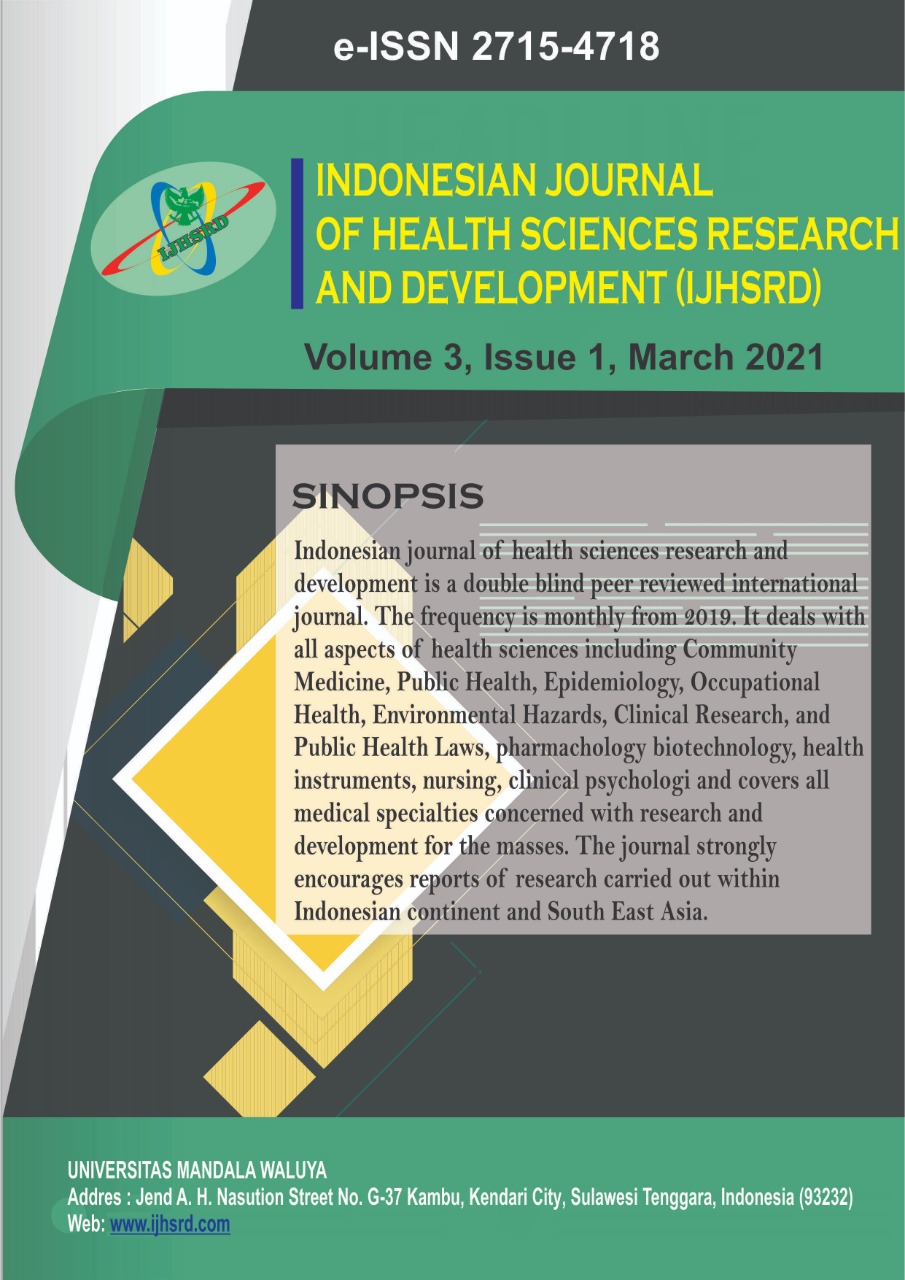Main Article Content
Abstract
Background: Data from the Ministry of Manpower of the Republic of Indonesia that the number of work accidents in Indonesia in 2016 was 101,368, in 2017 there were 123,041 cases, in 2018 there were 173,415 cases. At the end of September 2019 there were 130,923 cases and there were 6 people who died every day. On September 2019, the sectors that contributed to the relatively large number of work accidents were the processing industry with 50,358 (38.46%) cases, trade of 9,559 (7.30%) cases, transportation and warehousing 2,694 (2.06%) cases, and the rest 68,312 (52.18%) cases from other sectors. The same thing was reported by the Social Security Administration for Employment that there was an increase in work accidents by 40%, from 157,313 in 2018 to 173,105 cases in 2019.
Methods: This research is quantitative research with a descriptive analytic research design and applied observational analytic approach. The population of all loading and unloading workers was 150 people divi ded into 3 teams, where each team consisted of 50 TKBM members of Bungkutoko Port, Kendari City.
Result: This study found 3 work stages with the highest RPN value, namely, wrong in the lifting position in the stevedore of work process at the time workers lift goods and put them into the net, as well as in the cargodore of work process when workers stack goods on the truck with a value of 288, stumbling (cargo) which occurs in the stevedoring work process where The worker on the truck directs the crane and the net into the truck body with an RPN value of 192, and pinched by a lifting tool in the cargodore of work process when workers remove goods from the sling on the truck / remove the sling, with a value of RPN 144.
Conclusion: There were 3 loading and unloading work processes, namely, stevedoring, cargodoring, and delivery with each work stage having potential hazards, the impact of hazards, and control efforts, and the person in charge of control efforts.
Keywords
Article Details

This work is licensed under a Creative Commons Attribution-ShareAlike 4.0 International License.
References
- Van Daele J. The International Labor Organization (ILO) in past and present research. International Review of Social History. 2008; 53 (3): 485-511.
- Nazirah R, Yuswardi Y. Nurse Behavior in the Implementation of Occupational Health and Safety Management (K3) in Aceh. Idea nursing journal. 2017; 8 (3).
- Khairunnisa K. Report on Field Work Practices (PKL) at the Ministry of Manpower of the Republic of Indonesia. 2019.
- BPJS of Employment. BPJS Ketenagakerjaan Data for Southeast Sulawesi Province 2019.
- Tunas Bangsa Mandiri Cooperative. Profile of Bungkutoko Port, located in Abeli District, Kendari City, Southeast Sulawesi Province 2019.
- Faniah AM, Suwaji MK. Factors Related To Compliance With The Use Of Apd Earplugs And Gloves In Repair Unit Workers AT PT. Kai Daop VI Yogyakarta Dipo Solo Racing: Muhammadiyah University Surakarta; 2016.
- Mackey A, Gass SM. Second language research: Methodology and design: Routledge; 2015.
- Sugiyono. Nonparametric Statistics for Research. 2015.
- Simanjuntak RA, Abdullah R. Overview of Systems and Performance Management of Underground Mine Safety & Health CV. Tahiti Coal, Talawi, Sawahlunto, West Sumatra. Mine Development. 2018; 3 (4): 1536-45.
- Ilmansyah Y, Mahbubah NA, Widyaningrum D. Implementation of Job Safety Analysis as an Effort to Prevent Work Accidents and Improve Work Safety at Pt Shell Indonesia. Proficiency. 2020; 8 (1): 15-22.
- Widiantoro O, Kusnan K, Suparji S, Rijanto T. Differences in Learning Outcomes Using Direct Learning Models Viewed from Spatial Ability: Study At Basic Survey Working Lesson in the Engineering Surveying. International Journal for Educational and Vocational Studies. 2020; 2 (4).
- Husna FA. Compliance with the use of personal protective equipment for loading and unloading workers (TKBM) of ships at Belawan Harbor, the working area of the Class 1 Port Health Office (KKP) in Medan. 2019.
- Aryani I. Risk assessment on log loading and unloading work (Study at the Deep Port of Tanjung Emas in Semarang): UNIMUS; 2016.
- Medianto D. Factors Associated with Work Fatigue in the Loading and Unloading Workers (TKBM) at the Port of Tanjung Emas, Semarang (Study on TKBM Workers in the Fertilizer Packing Unit): Muhammadiyah University of Semarang; 2017.
- Saragih¹ WL, Mahyuni EL, Lubis AM. Assessment of Work Accident Risk in Loading and Unloading Workers at Teluk Nibung Port, Tanjung Balai Asahan in 2015. University of North Sumatra; 2015.
- Utami U, Karimuna SR, Jufri NN. Relationship of Length of Work, Work Attitude and Workload with Musculoskeletal Disorders (MSDs) on Rice Farmers in Ahuhu Village, Meluhu District, Konawe Regency in 2017. (Public Health Student Scientific Journal). 2017; 2 (6).
- Prasetio DB, Aryani I, Meikawati W. Risk Assessment of Loading and Unloading Work at Nusantara Tanjung Emas Port, Semarang. 2016.
- Ramisdar IO. Analysis of Work Accident Risk in the Loading and Unloading Process Using the Job Safety Analysis (JSA) Method and the Hazard and Operability Study (HAZOPs) at PT Pelindo IV (Persero) Makassar Container Terminal: Alauddin Makassar Islamic State University; 2019.
- Kurniawan Y, Kurniawan B, Ekawati E. Knowledge Relationship, Fatigue, Physical Workload, Body Posture at Work, and Attitudes of Using Apd with Occupational Accidents (Studies on Manual Lifting Activities in the Fertilizer Packaging Unit of Tanjung Emas Port Semarang) Journal of Public Health (e-Journal). 2018; 6 (4): 393-401.
- Restuputri DP, Sari RPD. Work accident analysis using the Hazard and Operability Study (HAZOP) method. Industrial Engineering Scientific Journal. 2015; 14 (1): 24-35.
